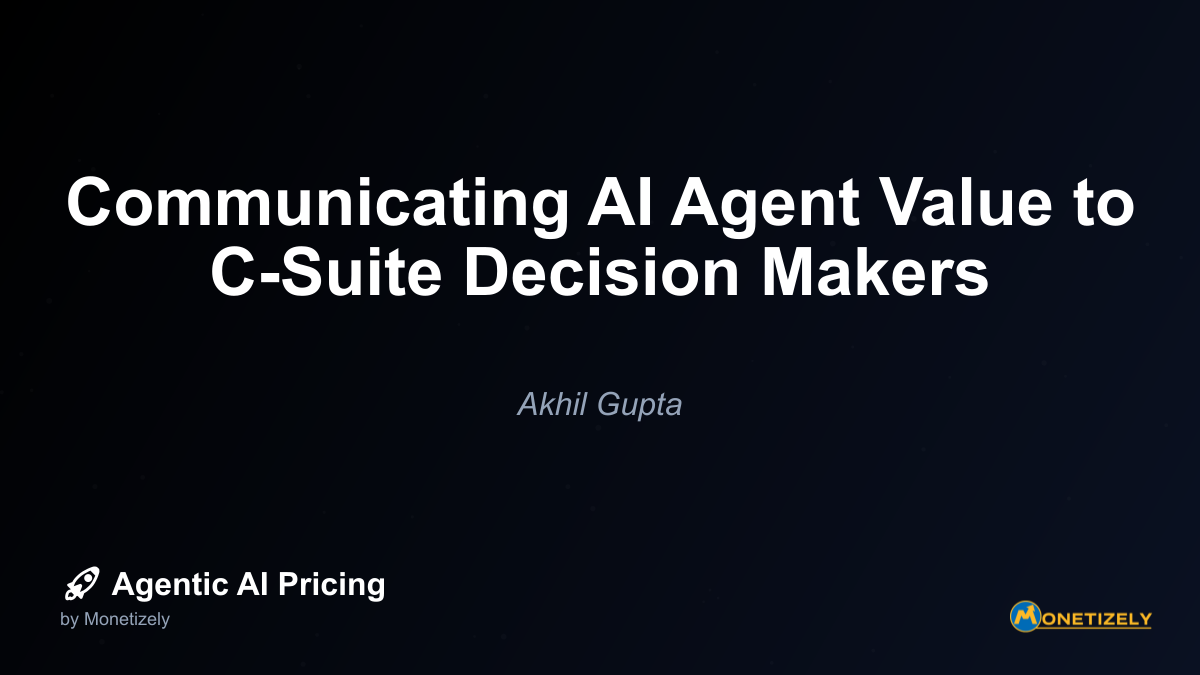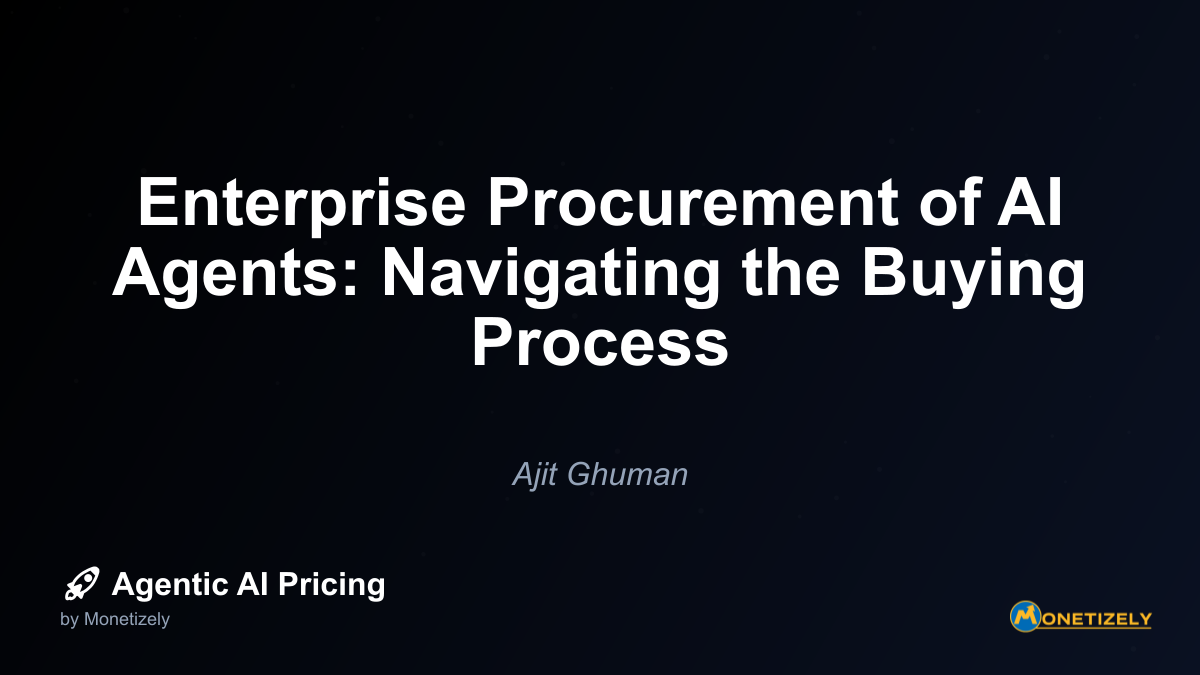· Akhil Gupta · Communication & Messaging · 8 min read
Communicating AI Agent Value to C-Suite Decision Makers
AI and SaaS Pricing Masterclass
Learn the art of strategic pricing directly from industry experts. Our comprehensive course provides frameworks and methodologies for optimizing your pricing strategy in the evolving AI landscape. Earn a professional certification that can be imported directly to your LinkedIn profile.

Business Outcome Mapping
With a clear understanding of technical capabilities, the next step is mapping these to specific business outcomes that matter to executives. This translation process requires:
- Direct Impact Assessment: Identify the immediate business impact of each capability
- Indirect Benefit Analysis: Recognize secondary and tertiary benefits
- Quantification Methodology: Establish how impacts will be measured
- Strategic Alignment: Connect to existing business priorities
For example, an AI agent’s ability to “process unstructured customer communications with 95% accuracy” translates to business outcomes such as:
- Direct impact: 60% reduction in customer response time
- Indirect benefit: 22% increase in customer satisfaction scores
- Quantification: Measured through resolution time metrics and NPS
- Strategic alignment: Supports the company’s customer experience initiative
This mapping process creates clear connections between technical capabilities and business value, which forms the foundation for executive communication.
Value Proposition Articulation
With capabilities mapped to outcomes, the next step is crafting compelling value propositions that resonate with executive stakeholders. Effective articulation includes:
- Clear Value Statements: Concise expressions of business impact
- Executive-Friendly Language: Terminology familiar to business leaders
- Compelling Visuals: Charts, diagrams, and dashboards that illustrate value
- Comparative Analysis: How the solution compares to alternatives
For example, a value proposition for an AI agent might be articulated as: “Our customer service AI agent reduces operational costs by $2.4M annually while improving customer satisfaction by 22% through faster, more accurate response handling.”
These value propositions should avoid technical jargon and focus on business outcomes that matter to executives. Visual representations can powerfully illustrate the connection between technical capabilities and business value, making abstract concepts tangible.
Stakeholder-Specific Customization
The final step in the Value Translation Framework involves customizing communication for specific executive stakeholders. This ensures that presentations address the unique concerns and priorities of each C-suite member:
For the CEO:
- Emphasize competitive differentiation and strategic advancement
- Highlight market positioning and growth opportunities
- Connect to long-term vision and organizational transformation
For the CFO:
- Focus on detailed ROI analysis and cost reduction
- Present clear implementation timelines with financial milestones
- Address risk management and resource allocation considerations
For the CTO:
- Balance technical innovation with implementation feasibility
- Discuss integration with existing technology infrastructure
- Address technical debt and scalability considerations
For the COO:
- Detail operational efficiency improvements and process optimization
- Outline implementation timeline and change management approach
- Present clear performance metrics and success indicators
For the CMO:
- Highlight customer experience enhancements and market perception
- Discuss competitive differentiation and brand positioning
- Present metrics for measuring market impact and customer engagement
By tailoring communication to each stakeholder’s specific concerns, you increase the likelihood of gaining executive support for AI agent initiatives.
The ROI Framework for AI Agents
When communicating with C-suite stakeholders, particularly CFOs, a robust ROI framework is essential. The challenge with AI agent implementations is that they often deliver value across multiple dimensions, some of which are difficult to quantify. A comprehensive ROI framework addresses this challenge by:
Identifying Cost Components
- Implementation costs (technology, integration, customization)
- Operational costs (maintenance, updates, monitoring)
- Training and change management costs
- Scaling and expansion costs
Quantifying Direct Benefits
- Labor cost reduction through automation
- Increased throughput and processing capacity
- Error reduction and quality improvements
- Revenue enhancement through improved capabilities
Assessing Indirect Benefits
- Customer experience improvements
- Employee satisfaction and retention
- Competitive differentiation
- Organizational agility and innovation capacity
Establishing Timeline Expectations
- Short-term wins (0-6 months)
- Medium-term improvements (6-18 months)
- Long-term strategic advantages (18+ months)
This framework provides a structured approach to communicating the comprehensive value of AI agent implementations, addressing the multifaceted nature of their business impact.
Learn more about comprehensive ROI measurement frameworks for AI agent implementationsEffective Communication Strategies for Executive Presentations
Beyond frameworks for value translation, specific communication strategies can enhance the effectiveness of executive presentations:
The 3-10-30 Rule for Executive Presentations
When presenting AI agent value propositions to C-suite stakeholders, the 3-10-30 rule provides a useful structure:
- 3-Minute Executive Summary: A concise overview highlighting key business outcomes, required investment, and strategic alignment
- 10-Minute Presentation: A focused walkthrough of core value propositions, implementation approach, and success metrics
- 30-Minute Detailed Documentation: Comprehensive supporting materials available for deeper exploration
This approach respects executives’ time constraints while providing appropriate detail for decision-making. The 3-minute summary is particularly critical, as it may be the only portion that captures complete attention.
Storytelling with Business Impact
Narrative frameworks help executives connect with AI agent value propositions on both rational and emotional levels:
Challenge-Solution-Outcome Structure
- Clearly articulate the business challenge
- Present the AI agent as a strategic solution
- Illustrate outcomes with concrete examples and metrics
Case Study Approach
- Share relevant success stories from similar implementations
- Present before-and-after scenarios with quantifiable improvements
- Address challenges encountered and how they were overcome
Day-in-the-Life Comparisons
- Illustrate how operations function before implementation
- Contrast with improved processes after implementation
- Highlight both efficiency gains and experience improvements
These narrative approaches make abstract technical concepts tangible by connecting them to familiar business contexts and human experiences.
Visual Communication Principles
Visual elements significantly enhance executive understanding of AI agent value:
Value Flow Diagrams
- Visually map technical capabilities to business outcomes
- Use color and size to indicate impact magnitude
- Show connections to strategic initiatives
Comparative Dashboards
- Present before-and-after performance metrics
- Highlight key performance indicators relevant to each stakeholder
- Use visual hierarchy to emphasize most significant impacts
Implementation Roadmaps
- Visualize the implementation timeline with key milestones
- Indicate investment requirements and value realization points
- Show dependencies and critical path elements
Visual communication tools transform complex technical concepts into accessible business insights, facilitating executive understanding and decision-making.
Addressing Common Executive Concerns
Effective communication anticipates and addresses typical executive concerns about AI agent implementations:
ROI Uncertainty and Measurement Challenges
Many executives express concern about uncertain returns and measurement difficulties:
Proactive Approaches:
- Establish clear baseline metrics before implementation
- Define specific success criteria with measurement methodologies
- Implement phased approaches with early validation points
- Create ROI dashboards with real-time performance tracking
Communication Strategy:
- Acknowledge measurement challenges transparently
- Present conservative estimates with supporting evidence
- Propose pilot implementations with defined success criteria
- Share relevant benchmark data from similar implementations
Implementation Risk and Organizational Disruption
Executives often worry about implementation complexity and operational disruption:
Proactive Approaches:
- Develop detailed implementation plans with risk mitigation strategies
- Establish clear change management and training approaches
- Define fallback procedures and contingency plans
- Create phased implementation with controlled expansion
Communication Strategy:
- Address risks directly rather than minimizing concerns
- Present specific risk mitigation strategies for identified concerns
- Highlight organizational readiness factors and preparatory steps
- Share success stories addressing similar implementation challenges
AI Ethics and Governance Concerns
Increasingly, executives express concerns about AI ethics, bias, and governance:
Proactive Approaches:
- Integrate ethics considerations throughout development
- Implement monitoring for bias and fairness issues
- Establish clear governance frameworks and oversight
- Develop transparent documentation of AI decision processes
Communication Strategy:
- Address ethical considerations proactively
- Present governance frameworks and monitoring approaches
- Highlight compliance with relevant regulations and standards
- Demonstrate commitment to responsible AI development
By anticipating and addressing these common concerns, you demonstrate thoroughness and build executive confidence in AI agent implementations.
Case Study: Communicating AI Agent Value in Financial Services
To illustrate these frameworks in action, consider this case study of a financial services organization implementing an AI agent for customer service and fraud detection:
The Challenge
A mid-sized financial institution sought executive approval for implementing an AI agent system to enhance customer service while strengthening fraud detection. The technical team understood the solution’s capabilities but struggled to communicate value effectively to the executive committee.
The Approach
The team applied the Value Translation Framework to develop stakeholder-specific presentations:
For the CEO:
- Emphasized competitive differentiation in customer experience
- Highlighted potential for 15% reduction in customer churn
- Connected to strategic digital transformation initiatives
For the CFO:
- Presented detailed ROI analysis showing 267% return over three years
- Outlined $3.2M in operational savings through automation
- Demonstrated $4.7M in fraud prevention benefits
For the CTO:
- Addressed integration with existing systems and data architecture
- Presented implementation timeline with technical milestones
- Discussed scalability and future capability expansion
For the COO:
- Detailed operational efficiency improvements across departments
- Presented process optimization opportunities and workflow enhancements
- Outlined change management approach and training requirements
For the CMO:
- Highlighted customer experience improvements with quantified NPS impact
- Demonstrated competitive differentiation in service capabilities
- Presented marketing opportunities from enhanced capabilities
The Result
The executive committee approved the implementation with full funding, citing the clear business case and alignment with strategic priorities. The project launched with strong cross-functional support and delivered outcomes that exceeded initial projections.
This case illustrates how effective translation of technical capabilities into business outcomes, combined with stakeholder-specific communication, can secure executive support for AI agent implementations.
Building an Executive Communication Playbook
To systematize effective executive communication about AI agent value, consider developing an organizational playbook that includes:
Value Translation Templates
- Standardized formats for mapping capabilities to outcomes
- Executive-friendly language guidelines and terminology
- Visual communication templates and standards
Stakeholder Communication Guides
- Role-specific messaging frameworks for each C-suite position
- Question anticipation and response guidelines
- Meeting structure recommendations and presentation templates
ROI Calculation Methodologies
- Standardized approaches for quantifying different benefit types
- Guidance for addressing hard-to-measure benefits
- Templates for presenting financial projections and assumptions
Implementation Narrative Frameworks
- Structured approaches for telling the implementation story
- Case study templates highlighting business impact
- Visual storytelling guidelines for executive presentations
This playbook approach ensures consistent, effective communication about AI agent value across the organization, building cumulative expertise in executive engagement.
Explore effective strategies for communicating outcome-based AI pricing to financial leadersConclusion: Keys to Effective C-Suite Communication
Successfully communicating AI agent value to executive stakeholders requires a strategic approach that translates technical capabilities into business outcomes. The frameworks and strategies outlined in this article provide a structured methodology for this critical communication process:
- Understand distinct C-suite perspectives and tailor communications accordingly
- Apply the Value Translation Framework to connect technical capabilities to business outcomes
- Develop comprehensive ROI models that address both direct and indirect benefits
- Use effective communication strategies including the 3-10-30 rule and visual storytelling
- Proactively address common executive concerns about implementation and measurement
- Create an organizational playbook to systematize effective executive communication
By applying these approaches, professionals can bridge the gap between technical capabilities and business value, securing executive support for AI agent initiatives and ensuring organizational alignment around implementation goals.
The most successful AI agent implementations begin with effective communication that helps executives understand not just what the technology does, but how it delivers strategic value to the organization. By focusing on business outcomes rather than technical capabilities, you transform AI agents from interesting technologies into strategic business assets worthy of executive support and investment.
Co-Founder & COO
Akhil is an Engineering leader with over 16+ years of experience in building, managing and scaling web-scale, high throughput enterprise applications and teams. He has worked with and led technology teams at FabAlley, BuildSupply and Healthians. He is a graduate from Delhi College of Engineering and UC Berkeley certified CTO.
Pricing Strategy Audit
Let our experts analyze your current pricing strategy and identify opportunities for improvement. Our data-driven assessment will help you unlock untapped revenue potential and optimize your AI pricing approach.




